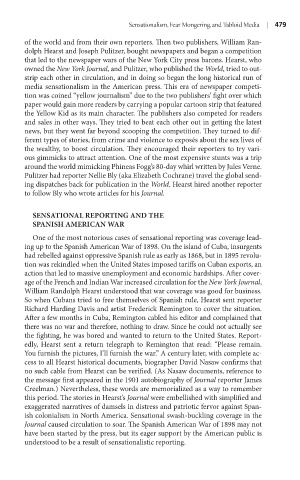Page 500 - Battleground The Media Volume 1 and 2
P. 500
Sensat onal sm, Fear Monger ng, and Tablo d Med a |
of the world and from their own reporters. Then two publishers, William Ran-
dolph Hearst and Joseph Pulitzer, bought newspapers and began a competition
that led to the newspaper wars of the New York City press barons. Hearst, who
owned the New York Journal, and Pulitzer, who published the World, tried to out-
strip each other in circulation, and in doing so began the long historical run of
media sensationalism in the American press. This era of newspaper competi-
tion was coined “yellow journalism” due to the two publishers’ fight over which
paper would gain more readers by carrying a popular cartoon strip that featured
the Yellow Kid as its main character. The publishers also competed for readers
and sales in other ways. They tried to beat each other out in getting the latest
news, but they went far beyond scooping the competition. They turned to dif-
ferent types of stories, from crime and violence to exposés about the sex lives of
the wealthy, to boost circulation. They encouraged their reporters to try vari-
ous gimmicks to attract attention. One of the most expensive stunts was a trip
around the world mimicking Phineas Fogg’s 80-day whirl written by Jules Verne.
Pulitzer had reporter Nellie Bly (aka Elizabeth Cochrane) travel the global send-
ing dispatches back for publication in the World. Hearst hired another reporter
to follow Bly who wrote articles for his Journal.
sEnsaTionaL rEPorTing anD ThE
sPanish amEriCan war
One of the most notorious cases of sensational reporting was coverage lead-
ing up to the Spanish American War of 1898. On the island of Cuba, insurgents
had rebelled against oppressive Spanish rule as early as 1868, but in 1895 revolu-
tion was rekindled when the United States imposed tariffs on Cuban exports, an
action that led to massive unemployment and economic hardships. After cover-
age of the French and Indian War increased circulation for the New York Journal,
William Randolph Hearst understood that war coverage was good for business.
So when Cubans tried to free themselves of Spanish rule, Hearst sent reporter
Richard Harding Davis and artist Frederick Remington to cover the situation.
After a few months in Cuba, Remington cabled his editor and complained that
there was no war and therefore, nothing to draw. Since he could not actually see
the fighting, he was bored and wanted to return to the United States. Report-
edly, Hearst sent a return telegraph to Remington that read: “Please remain.
You furnish the pictures, I’ll furnish the war.” A century later, with complete ac-
cess to all Hearst historical documents, biographer David Nasaw confirms that
no such cable from Hearst can be verified. (As Nasaw documents, reference to
the message first appeared in the 1901 autobiography of Journal reporter James
Creelman.) Nevertheless, these words are memorialized as a way to remember
this period. The stories in Hearst’s Journal were embellished with simplified and
exaggerated narratives of damsels in distress and patriotic fervor against Span-
ish colonialism in North America. Sensational swash-buckling coverage in the
Journal caused circulation to soar. The Spanish American War of 1898 may not
have been started by the press, but its eager support by the American public is
understood to be a result of sensationalistic reporting.

